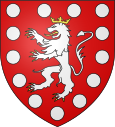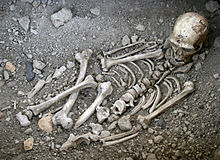La Chapelle-aux-Saints
| La Chapelle-aux-Saints | ||
|---|---|---|

|
|
|
| region | Nouvelle-Aquitaine | |
| Department | Corrèze | |
| Arrondissement | Brive-la-Gaillarde | |
| Canton | Midi Corrézien | |
| Community association | Midi Corrézien | |
| Coordinates | 44 ° 59 ′ N , 1 ° 44 ′ E | |
| height | 120-191 m | |
| surface | 4.72 km 2 | |
| Residents | 266 (January 1, 2017) | |
| Population density | 56 inhabitants / km 2 | |
| Post Code | 19120 | |
| INSEE code | 19044 | |
La Chapelle-aux-Saints is a French municipality with 266 inhabitants (at January 1, 2017) in the department of Corrèze in the region Nouvelle-Aquitaine . The residents call themselves Capeloux .
The name of the community became known worldwide at the beginning of the 20th century after the discovery of what was then the most complete fossil of a Neanderthal man ( Homo neanderthalensis ).
geography
The village is affected by a stream called Sourdoire and belongs to the canton of Beaulieu-sur-Dordogne in the Arrondissement of Brive-la-Gaillarde . Neighboring municipalities are Branceilles in the northwest, Curemonte in the northeast, Végennes in the southeast, Bétaille and Vayrac in the south and Saint-Michel-de-Bannières in the west.
La Chapelle-aux-Saints is the lowest point in the canton , at 120 m
coat of arms
Description : In red with a silver ball border, a gold-crowned and gold- armored and tongued silver upright lion .
Neanderthal find
The Neanderthal man known as La Chapelle-aux-Saints 1 was discovered on August 3, 1908. It consisted of a very well preserved skull with associated lower jaw and numerous other body bones. In science he was nicknamed "the old man of La Chapelle" because his age was initially estimated at 60 years; in fact, however, he probably died at a much younger age.
The site, a cave called La Bouffia Bonneval , was visited by the brothers Abbè Jean and Abbè Amèdèe Bouyssonie and their colleagues Abbè Louis Bardon in 1908 during their joint inventory and mapping of collections of prehistoric stone tools . In the course of a trial excavation, they came across the 50,000 to 60,000 year old remains of a male individual in the cave, all sunk in a pit that would later prove to be a burial site. The anatomical features typical of a “classic Neanderthal” are clearly defined: including a longitudinally oval skull shape, distinctive bulges above the eyes , a relatively flat forehead and a receding chin. What is noticeable about this find are also the teeth that have largely been lost during life as well as signs of advanced arthritis , which must have led to restricted mobility and the need for help.
Population development
| year | 1962 | 1968 | 1975 | 1982 | 1990 | 1999 | 2008 | 2017 |
|---|---|---|---|---|---|---|---|---|
| Residents | 236 | 221 | 217 | 206 | 179 | 164 | 206 | 266 |
Web links
Individual evidence
- ↑ Winfried Henke in: The Neanderthals. (Ed. Elmar-Björn Krause): Edition Archaea, Gelsenkirchen 1999, ISBN 3-929439-76-X , article: appearance, p. 17f.
- ^ Ian Tattersall: Puzzle Human Becoming, Spektrum Verlag, Heidelberg 1997, ISBN 3-8274-0140-2 , p. 65.
- ^ Tappen: The Dentition of the “Old Man” of La Chapelle-aux-Saints and Inferences Concerning Neanderthal Behavior. American Journal of Physical Anthropology, NC 1985, p. 67 (1), pp. 43-50.

